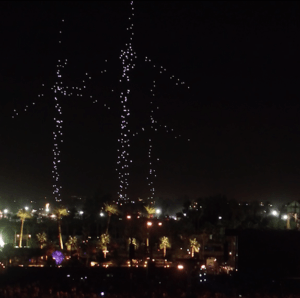
The drones’ appearance at Coachella – the star-studded, giant music festival held in the Coachella valley – was only the latest of Intel’s performances. Since their debut in November of last year, the Shooting Star drones have broken a world record for the Most Unmanned Aerial Vehicles (UAVs) airborne simultaneously (500 of them) and appeared at two classic US spectaculars: Disney and the SuperBowl.
4 Billion Color Combinations
Intel Shooting Star drones are designed just for entertainment. The drones weigh about 280 grams – a little less than a volleyball – and are made of flexible plastic and foam, with no screws. They are equipped with built-in LED lights which can create over 4 billion color combinations. The drones are less dangerous than traditional fireworks: the quad’s propellers are protected by covered cages, making them both safer and weatherproof. Intel’s automated system and animation software allows designers to create a choreographed light show in a fraction of the time it would take to do it manually.
A Demonstration of Drone Fleets
Intel’s Shooting Star drones represent a lot of technology advances. While the use of drones for entertainment is a new idea, Intel’s system demonstrates what can be done by a single operator controlling not one, but hundreds of drones. Intel’s proprietary algorithms focus on the animation creation process. They take an image and calculate the number of drones required, figure out where the drones should be and formulate the fastest path to create the image. But the same idea – determining where hundreds of drones should be positioned and calculating the fastest way to get them there – has tremendous commercial applications.
Intel’s software also runs a complete fleet check prior to each flight, selecting “the most optimized drones for each flight based on battery life, GPS reception and more,” says Intel. Right now Intel’s Shooting Stars are just making pretty light shows: but with automated fleet management and a single pilot on the ground controlling hundreds – or even thousands – of drones in the air, the possibilities are endless.
Here’s a short sample, courtesy of Intel and Cody Burkhardt of Golden Voice Media:
Miriam McNabb is the Editor-in-Chief of DRONELIFE and CEO of JobForDrones, a professional drone services marketplace, and a fascinated observer of the emerging drone industry and the regulatory environment for drones. Miriam has penned over 3,000 articles focused on the commercial drone space and is an international speaker and recognized figure in the industry. Miriam has a degree from the University of Chicago and over 20 years of experience in high tech sales and marketing for new technologies.
For drone industry consulting or writing, Email Miriam.
TWITTER:@spaldingbarker
Subscribe to DroneLife here.